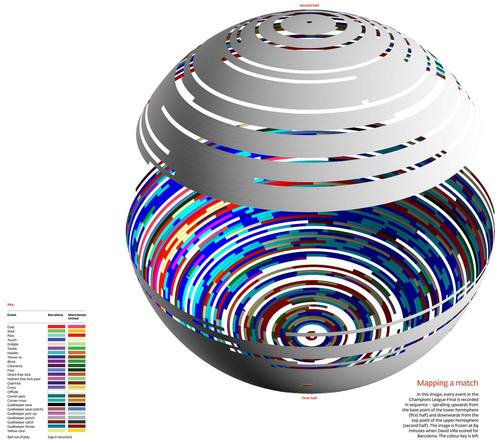
Every data point (pass, cross, offside, out of play etc) mapped in these two hemispheres (one for each half) between Man Utd and Barca in the Champions League finals.
Simon Kuper’s fascinating article in the FT about how the data revolution is slowly changing the face of soccer. There might be a time when quants will emerge from their gray shadows and take their rightful place on the cover of Four Four Two.
Michael Lewis’s book Moneyball made famous Billy Beane’s use of statistics to transform the underrated Oakland Athletics into giant killers. Some of the more savvy soccer managers read the book and wanted to know if it could produce similar results. It led to a number of clubs like Chelsea and Spurs brainstorming Beane on how soccer data could be used to improve performances and make the correct transfer choices.
Damien Comolli now at Liverpool first crunched numbers in 2005 while at Spurs with his input directly responsible for the hiring of Luka Modric, Gareth Bale, and Dimitar Berbatov. He had befriended Beane as had Mike Forde, Chelsea’s performance director. Both men kept up the contact with the Oakland A’s manager whose passion had now turned to data crunching and analyzing soccer matches.
Comolli and Forde were following in the footsteps of Arsene Wenger and Sam Allardyce who were pioneers in the use of data. Wenger used computer programs in Monaco and brought his mathematical background to Arsenal changing the guts and glory ethos of George Graham. Big Sam used his data points to forge Bolton into one of the toughest defending units while relying on set pieces to score goals.
Claude Makelele is cited as a prime example of how statistics can go beyond the human eye. He was let go by Real Madrid as Fiorentino Perez was unimpressed by the holding midfielder’s lack of pace and technique which resulted in faster players overlapping him. The CEO also believed he lacked any meaningful distribution skills.
Makelele went on to spend five fruitful years with Chelsea while Real’s fortunes nosedived. Statistics later proved that Makelele was one of those players who thrive when the opposition has the ball. More than anyone else he was responsible for snuffing out attacking moves because he would raise his intensity levels to extra-ordinary levels.
The football data revolution is catching on and it might be one way to keep smaller clubs competitive by hiring smart quants to decipher how to deal with their wealthier opposition. The challenge is to make statistics smarter, i.e., correlative, to find factors that can significantly impact outcomes, in this instance, goals. For e.g., total distance covered does not really influence matches but the distance run at top speeds does. Which made Thierry Henry so lethal. Soccer’s free flowing nature makes gathering discrete data points challenging but a new generation of computer programs, motion capture software, and analysts are overturning these precepts. Unleash the quants.
One comment on “Soccer’s data revolution: To be pitch perfect”
Excellent read